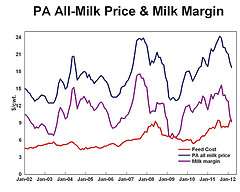Expansions in dairy industry lead to surplus, lows for milk prices

One source of income for Pennsylvania dairy farmers has hit its lowest point in three years, according to a dairy market expert in Penn State's College of Agricultural Sciences.
James Dunn, professor of agricultural economics, said that in May, milk margin per hundredweight -- the income portion left to pay dairy producers' bills for inputs other than feed, such as electricity, equipment and labor -- hit its lowest point in Pennsylvania since September 2009.
"This is starting to really eat up the farmers," Dunn said. "The milk price is not historically low, but the feed price is so high that the amount that's left is not good."
The 2012 Pennsylvania average milk price is estimated to be $2.14 per hundredweight lower than it was in 2011.
Feed prices and difficulty with weather and crop harvests have contributed to dairy producers' struggles. Last year's wet seasons hindered farmers' ability to produce feed for their dairy herds. Dunn said some producers are running out of corn silage.
Exports and the strength of the American dollar also have played a role in the fluctuating milk prices. With the amount of milk produced per cow increasing -- creating more milk than the US population can consume -- dairy-product exports must increase or cow numbers must shrink to balance supply and demand.
Increased exports in the last year have meant the dairy industry could grow. In 2011, 14 percent of domestic milk production was exported, and prices were favorable. The exports were boosted by bad weather in Australia and New Zealand, leading to low milk production in those countries. Food-safety concerns related to Chinese products also were a factor, as well as a then-weak U.S. dollar.
Dairy producers used the favorable dairy prices to make largely the same decisions.
"The problem always in agriculture is everybody looks at the same information and reaches the same conclusions," Dunn said. "And when producers saw really nice prices, everybody said, 'I'm going to expand.'"
With the expansions came 4 percent more milk production in January through March than the same months in 2011. However, sales of milk could not increase at the same rate.
Now the industry is trying to figure out how to adjust surpluses. Dunn said that could happen in two ways: finding more customers for the milk, and encouraging the industry to expand more slowly. The latter is happening gradually, and the growth in milk production in April was lower than it was in March.
Now, the dairy industry needs to increase its exports by 20 percent, an amount Dunn said is substantial.
"It's one thing to have your market grow by 3 or 4 percent, but where are you going to find 20 percent more customers than you had last year?" he asked. "The world population is growing, and you can have some bad weather, but that's too much to expect."
Another factor hurting the dairy industry is the recent strengthening of the U.S. dollar against some other currencies, which Dunn said hurts American exports. For example, compared to the euro, the value of the dollar is high, having increased by more than 10 percent in the last few months. The strong dollar negatively affects export sales because it drives up the prices for American goods.
"If we have a strong dollar, we can buy other people's stuff for a good price, and our stuff is expensive to them," Dunn said, emphasizing that agriculture is driven largely by exports.
He added that a number of farmers are thinking of concentrating on crops instead of dairy.
"Ordinarily, land in Pennsylvania is not suitable to be really competitive in corn and soybeans -- too many small fields -- but when the prices of corn and soybeans are high enough, then that works."
Provided by Pennsylvania State University


















